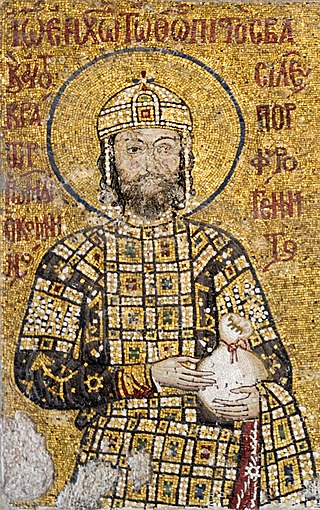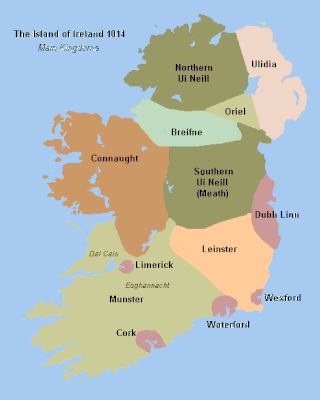| |||||
| Centuries: | |||||
|---|---|---|---|---|---|
| Decades: | |||||
| See also: | Other events of 1216 List of years in Ireland | ||||
Events from the year 1216 in Ireland.
| |||||
| Centuries: | |||||
|---|---|---|---|---|---|
| Decades: | |||||
| See also: | Other events of 1216 List of years in Ireland | ||||
Events from the year 1216 in Ireland.
The 1170s was a decade of the Julian Calendar which began on January 1, 1170, and ended on December 31, 1179.

Year 1128 (MCXXVIII) was a leap year starting on Sunday of the Julian calendar.
The Primacy of Ireland belongs to the diocesan bishop of the Irish diocese with highest precedence. The Archbishop of Armagh is titled Primate of All Ireland and the Archbishop of Dublin Primate of Ireland, signifying that they are the senior clerics on the island of Ireland, the Primate of All Ireland being the more senior. The titles are used by both the Catholic Church in Ireland and Church of Ireland. Primate is a title of honour, and in the Middle Ages there was an intense rivalry between Armagh and Dublin as to seniority. The Archbishop of Armagh's leading status is based on the belief that his see was founded by St. Patrick, making Armagh the ecclesiastical capital of Ireland. On the other hand, Dublin is the political, cultural, social, economic and secular centre of Ireland, and has been for many centuries, thus making the Archbishop of Dublin someone of considerable influence, with a high national profile. The dispute between the two archbishoprics was settled by Pope Innocent VI in 1353, with occasional brief controversy since. The distinction mirrors that in the Church of England between the Primate of All England, the Archbishop of Canterbury, and the Primate of England, the Archbishop of York.
The Lord High Chancellor of Ireland was the highest judicial office in Ireland until the establishment of the Irish Free State in 1922. From 1721 to the end of 1800, it was also the highest political office of the Irish Parliament: the Chancellor was Speaker of the Irish House of Lords. The Lord Chancellor was also Lord Keeper of the Great Seal of Ireland. In all three respects, the office mirrored the Lord High Chancellor of Great Britain.
Diarmait Mac Murchada, was King of Leinster in Ireland from 1127 to 1171. In 1167, he was deposed by the High King of Ireland, Ruaidrí Ua Conchobair. To recover his kingdom, Mac Murchada solicited help from King Henry II of England. His issue unresolved, he gained the military support of the Richard de Clare, 2nd Earl of Pembroke, thus initiating the Anglo-Norman invasion of Ireland.

Lorcán Ua Tuathail, known in English as Laurence O'Toole and in French as Laurent d'Eu, was Archbishop of Dublin at the time of the Norman invasion of Ireland. Lorcán played a prominent role in the Irish Church Reform Movement of the 12th century and mediated between the parties during and after the invasion. He was canonised in 1225 by Pope Honorius III.

The Treaty of Windsor (1175) was a territorial agreement made during the time of the Norman invasion of Ireland. It was signed in Windsor, Berkshire by King Henry II of England and the Ard Rí or High King of Ireland, Ruaidrí Ua Conchobair.

The Anglo-Norman invasion of Ireland took place during the late 12th century, when Anglo-Normans gradually conquered and acquired large swathes of land from the Irish, over which the kings of England then claimed sovereignty, all allegedly sanctioned by the papal bull Laudabiliter. At the time, Gaelic Ireland was made up of several kingdoms, with a High King claiming lordship over most of the other kings. The Anglo-Norman invasion was a watershed in Ireland's history, marking the beginning of more than 800 years of direct English and, later, British, conquest and colonialism in Ireland.

Laudabiliter was a bull issued in 1155 by Pope Adrian IV, the only Englishman to have served in that office. Existence of the bull has been disputed by scholars over the centuries; no copy is extant but scholars cite the many references to it as early as the 13th century to support the validity of its existence. The bull purports to grant the right to the Angevin King Henry II of England to invade and govern Ireland and to enforce the Gregorian Reforms on the semi-autonomous Christian Church in Ireland. Richard de Clare ("Strongbow") and the other leaders of the Anglo-Norman invasion of Ireland (1169–1171) claimed that Laudabiliter authorised the invasion. These Cambro-Norman knights were retained by Diarmuid MacMorrough, the deposed King of Leinster, as an ally in his fight with the High King of Ireland, Ruaidrí Ua Conchobair.
Events from the year 1224 in Ireland.
Milo Sweetman was a fourteenth-century Irish Archbishop of Armagh, who was noted for his fierce defence of the privileges of his archdiocese.
Events from the year 1350 in Ireland.
Events from the 1480s in England. This decade marks the beginning of the Tudor period.
The Archbishop of Dublin is the head of the Archdiocese of Dublin in the Catholic Church, responsible for its spiritual and administrative needs. The office has existed since 1152, in succession to a regular bishopric since 1028. The archdiocese is the metropolitan see of the ecclesiastical province of Dublin, and the archbishop is also styled the Primate of Ireland. The cathedral church of the archdiocese is Saint Mary's Pro-Cathedral in Dublin city, although the Church formally claims Christ Church as its cathedral, and the archbishop's residence is Archbishop's House in Drumcondra.
Events from the 1170s in England.
Events from the 1100s in England.

Henry de Loundres was an Anglo-Norman churchman who was Archbishop of Dublin from 1213 to 1228. He was an influential figure in the reign of John of England, an administrator and loyalist to the king. He is mentioned in the text of Magna Carta, the terms of which he helped to negotiate.
John Comyn, born in England, was Archbishop of Dublin, Ireland.
Tommaltach Ua Conchobair, bishop of Elphin and archbishop of Armagh, lived from c. 1150–1201.
Events from the year 1484 in Ireland.